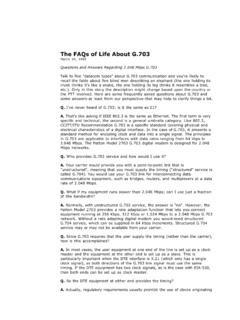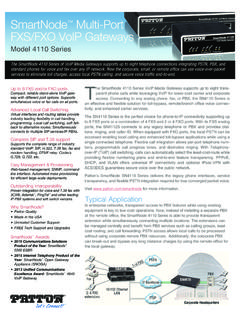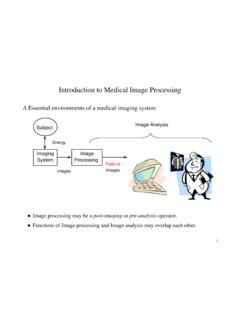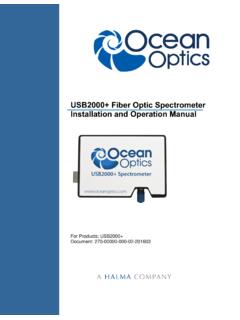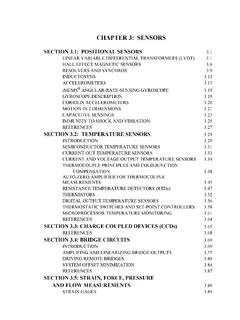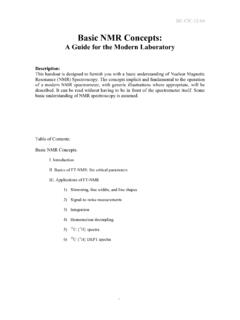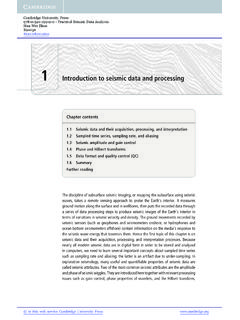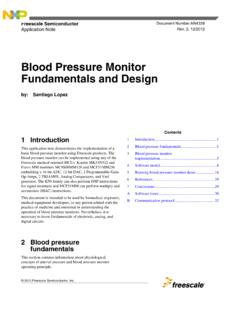Transcription of Introduction to SS7 Signaling - Patton
1 SS7 is a set of telephony Signaling protocols that areused to set up most of the world s public switched tele-phone network (PSTN) telephone calls. SS7 primarilysets up and tears down telephone calls, but other usesinclude number translation, prepaid billing mecha-nisms, local number portability, short message service(SMS), and a variety of mass-market toSS7 SignalingThis tutorial provides an overview of Signaling SystemNo. 7 (SS7) network architecture and protocolsCopyrightCopyright 2012, Patton Electronics Company. All rights reserved. Printed in the : Common Channel Signaling SystemNo. 7 (SS7 or C7)A worldwide standard for telecommunications definedby the International Telecommunication Union (ITU)Telecommunication Standardization Sector (ITU-T).
2 The SS7 standard defines the procedures and proto-col by which network elements in the public switchedtelephone network (PSTN) exchange information overa digital Signaling network to enable wireless (cellular)and wireline call setup, routing, and of SS7 American National Standards Institute (ANSI) and BellCommunications Research (Telcordia Technologies)standards used in North America and the EuropeanTelecommunications Standards Institute (ETSI) stan-dard used in SS7 network and protocol are used for: Basic call setup, management, and tear down Wireless services such as personal communica-tions services (PCS), wireless roaming, andmobile subscriber authentication Local number portability (LNP) Toll-free (800/888) and toll (900) wireline services Enhanced call features such as call forwarding,calling party name/number display, and three-way calling Efficient and secure worldwide telecommunications SMS (Short Message Service)SignalingEverything in the telecommunications network isbased on Signaling call setup, connection, teardown,and billing.
3 The two forms of Signaling that you aremost familiar with used by Patton products are: Channel Associated Signaling (CAS) RBS orMFR2 are examples of CAS Signaling (seeFigure 1). Common Channel Signaling (CCS) ISDN-PRI(see Figure 2).You already know ISDNI ntegrated Services digital Network Primary RateInterface (ISDN-PRI) divides digital transport servicesinto bearer channels (B-channels) for voice and datatransmission and data channels (D-channels) for sig-naling North America T1-PRI employs 24 channels(23B+1D at 64 Kbps per PCM channel) with an aggre-gate bandwidth of Mbps. In Europe E1-PRIemploys 32 channels (30B+2D at 64 Kbps per PCMchannel) with an aggregate bandwidth of the principal disadvantage of ISDN-PRI is itsuse of Associated Signaling mode, which only workswith directly trunked 1.
4 CAS: ESF, SF, RBS, MFR2 Figure 2. CCS: PRI-ISDNSS7 like ISDN uses a form of CCSW hile similar to ISDN-PRI, Signaling System NumberSeven (SS7) uses different messaging for call setupand teardown. SS7 lets any SS7-enabled node to talkto any other, regardless of whether they have directtrunk connections between preferred mode of Signaling for SS7 networks isQuasi-Associated, whereas ISDN-PRI uses theAssociated Signaling Links (Common channel Signaling )SS7 messages are 56 or 64 kbps bidirectional chan-nels called ( Signaling links) exchanged between net-work elements. Signaling occurs out-of-bandon dedi-cated channels rather than in-bandon voice is a form of common channel Signaling , that pro-vides intelligence to the network, and allows quickercall setup and teardown saving time and to in-band Signaling , out-of-band signal-ing provides.
5 Faster call setup times (compared to in-band sig-naling using multi-frequency (MF) Signaling tones) More efficient use of voice circuits Support for Intelligent Network (IN) serviceswhich require Signaling to network elements with-out voice trunks ( , database systems) Improved control over fraudulent network usage Lowering network operating costs by reducingSS7 Modes Associated Signaling Uses one dedicatedpath between switches as the Signaling : ISDN-PRI and E1-CAS. Non-Associated Signaling Uses separate logi-cal paths and multiple nodes. Quasi-Associated Signaling Uses a minimalnumber of nodes (preferred for SS7, causesless delay).Associated SignalingWith this type of Signaling , the Signaling link directlyparallels associated voice trunks.
6 Thus, dedicatedlinks must be provisioned between every intercon-nected switch. (See Figure 1-3.)Non-Associated SignalingWith this type of Signaling , voice/data and signalingare carried on separate, logical paths. Multiple nodesin the Signaling path to the final destination can cause4 Figure 1-3. Associated Signalingdelays. Although used in the SS7 network, it is not pre-ferred. (See Figure 1-4.)Quasi-Associated SignalingThis type of Signaling employs a minimal number ofnodes, thus minimizing delays. Quasi-associated sig-naling is the preferred Signaling mode for SS7. (SeeFigure 1-5.) Signaling PointsAll nodes in the SS7 network are called SignalingPoints (SPs).
7 Each SP is identified by a uniqueaddress called a Point Code (PC). SPs have the abili-ty to read a Point Code and determine if the messageis for that node and the ability to route SS7 messagesto another SP. Each Signaling point in the SS7 network is uniquelyidentified by a numeric point code. Point codes are car-ried in Signaling messages exchanged between signal-ing points to identify the source and destination of eachmessage. Each Signaling point uses a routing table toselect the appropriate Signaling path for each are three kinds of Signaling points in the SS7network (see Figure 6): SSP (Service Switching Point or SignalSwitching Point) STP (Signal Transfer Point) SCP (Service Control Point)Service Switching Point (SSP)SSPs are switches, for example, Class 5 (local) andClass 4 (tandem) with SS7 convert global title digits ( a dialed number)from a subscriber line to SS7 Signaling 1-4.
8 Non-Associated SignalingFigure 1-5. Quasi-Associated SignalingFigure 1-6. SS7 Signaling PointsSSPs setup, manage and release voice circuitsrequired to make a send messages using the ISDN User Part(ISUP) and Transaction Capabilities Application Part(TCAP) protocolsTo summarize, an SSP s function is to use a global titleto determine how to connect a call using itsrouting Transfer Point (STP):An STP is a router and/or a gateway in the SS7 are not originated by an switch SS7 messages between Signaling an originating SSP does not know the address of adestination SSP, the STP must provide it using GlobalTitle STPs serve as the interface into another net-work and they can provide protocol conversion.
9 STPs also provide traffic and usage Control Point (SCP)An SCP provides application access. It is an interfaceto applications such as SCP communicates with applications using primi-tives. A primitive is an interface that provides accessfrom one level of a protocol to another level. The protocol used to access and interface a databaseapplication is Signaling Links:All SPs ( Signaling points) are connected using (typi-cally) pairs of Links. Each Link type is identified with aletter as defined below: Type A Access Links (used to connectSSPs to STPs or STPs to SCPs)An A (access) link connects a Signaling end point (forexample, an SCP or SSP) to an STP. Only messagesoriginating from or destined to the Signaling end pointare transmitted on an A link.
10 Type B Bridge Links (used to connectpaired STPs to other paired STPs).A B (bridge) link connects an STP to another , a quad of B links interconnect peer (or pri-mary) STPs (for example, the STPs from one networkto the STPs of another network). The distinctionbetween a B link and a D link is rather arbitrary. Forthis reason, such links may be referred to as B/D C Cross Links (used to connectpaired STPs)A C (cross) link connects STPs performing identicalfunctions into a mated pair. A C link is used only whenan STP has no other route available to a destinationsignaling point due to link failure(s). Note that SCPsmay also be deployed in pairs to improve reliability;unlike STPs, however, mated SCPs are not intercon-nected by Signaling D Diagonal Links (used to con-nect paired STPs at one in the hierar-chy to paired STPs at another level inthe hierarchy)A D (diagonal) link connects a secondary (local orregional) STP pair to a primary (for example, inter-net-work gateway) STP pair in a quad-link STPs within the same network are con-nected via a quad of D links.

